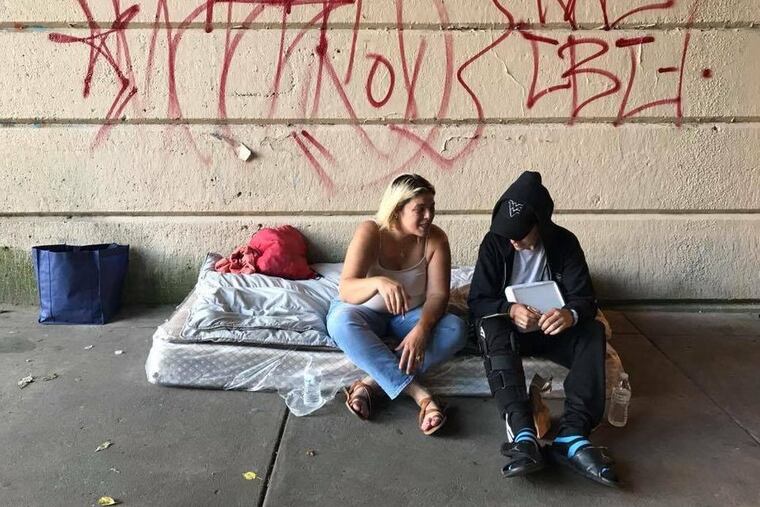These Kensington community leaders were fighting the heroin crisis long before Dr. Oz showed up | Commentary
The people in these neighborhoods have been promised a lot, but have received little actual help.

The Rev. Jessie Alejandro-Cruz was out on the 2700 block of Emerald Street in Kensington on Sunday. The 30 to 50 people who live beneath the underpass cleaned up used needles and other telltale signs of drug use before sitting down to eat with Alejandro-Cruz and 15 other members of the Free Church of St. John.
She isn't certain yet whether these are folks who were evicted from the Gurney Street heroin camp, which was cleaned up on July 31. What she does know, after 15 years of feeding and listening to the homeless drug users in the Kensington-Fairhill area, is that evicting drug users from an area isn't a solution for those grappling with addiction — or for the neighborhoods themselves.
On Aug. 7, the police evicted the residents of the Emerald Street underpass, too.
"It is so bad the way they did it," she says. "All of sudden the police came out to clean the area at 3 a.m. They told the people they had to go. They didn't offer any services. People just scattered."
Alejandro-Cruz is unconditional in her compassion toward the homeless drug users and her commitment to the neighborhoods impacted by drugs, but she's not alone. While Alejandro-Cruz focuses her efforts on Emerald Street, other community members do the same sort of on-the-ground work on Clearfield, Clementine, Howard, Lehigh and Cambria Streets.
One of those community members is Charito Morales, who has been working to address the area's concerns since 1998.
She refuses to use call the area "the Badlands," a name coined and used mostly by Anglo journalists writing about these neighborhoods. Nobody who actually lives in Kensington-Fairhill appreciates hearing the area referred to as "the Badlands." The term makes many of the Latino residents hesitant to talk to those who are on the outside, looking in. Morales calls it a "red zone."
She says that until the Inquirer and Daily News started writing about "El Campamento," she had a difficult time getting media and public officials to pay attention. She sees the newly realized cleanup efforts as well intentioned, but notes that some of that "outside, looking in" quality remains.
"I kept asking [the organizers of the cleanup at Second and Indiana], 'Where, where is the place that is going to take these individuals?'" she says. "There were some 300 people in the area, and only 11 beds available in one of the treatment sites, three in another. I knew it was going to be a huge mess."
Last week, the city released a progress report on the Gurney Street cleanup: About 250 tons of trash and debris have been hauled out of the encampment area, and about 141 of the evicted residents have met with outreach workers. Fifty of those have been referred to treatment services.
Outside of advising neighborhood folks to call 911 if they see someone in need of immediate medical attention, and calling 311 to report issues like illegal dumping and inadequate syringe disposals, the progress report includes no mention of the impacts the community has absorbed from the cleanup, or numbers related to the measures city government has taken to ameliorate those effects in the community.
Morales and Alejandro-Cruz describe the people of the neighborhoods they work in as having been promised a lot over the decades, but having received little actual help. Streets littered with syringes, and people shooting up in front of the neighborhood's children and elders, as well as gun violence and civic neglect of shared public areas, have kept people behind locked doors.
They are both deeply engaged in an interfaith peace march organized by the Free Church of St. John, which will take place Saturday from 7 to 8:30 p.m. It's an event they characterize as a homegrown effort to instill hope, build community, and engage everyone with a stake in their neighborhoods. Alejandro-Cruz says she has knocked on every door on Emerald Street to encourage attendance. On Aug. 26, there will be the first of what they hope will be an annual community day.
These events and the social hashtag #hope4thehood are the cornerstones for other initiatives — like safe injection sites, involving block captains and paid incentives — that the women see as possible solutions to some of the gravest crises in this section of the city.
Everyone from Dr. Oz to the BBC has now done a piece on the heroin camp in Kensington. Some of the pieces have been good, others are simply poverty and addiction porn. All of them have come from outside the community most impacted by both the existence of the camp and its cleanup. To get beyond one-shot sensationalism, what we need now is coverage that centers the voices of people like Alejandro-Cruz and Morales — who have been grappling with not only the implications but the actuality of this for decades.
So what do you say, Dr. Oz — care to come to an interfaith peace march?
Sabrina Vourvoulias is a Philadelphia-area Latina editor and journalist. She has written columns and commentary for the Guardian US, Philadelphia Magazine, and City and State Pennsylvania, and is the author of the novel "Ink."